By August of 2020, the 2,750 tons of ammonium nitrate in the Port of Beirut’s waterside Warehouse #12 had been there for six years. Warnings about the danger it posed had gone repeatedly unheeded. It was cargo long-abandoned by its owner: The ship that carried the chemical to port, in disrepair and leaking badly, had been abandoned in place and sunk at its moorings, just 1,000 feet to the north.
Late on the afternoon of Thursday, August 4, a small fire broke out in the warehouse. It ignited a cache of fireworks also stored in the building, and in turn, the abandoned ammonium nitrate.
The explosion from two vantage points. Slow motion video courtesy of Raw Space
The explosion ripped through the port, tearing apart storehouses, cranes, apartment buildings, and overturning ships. More than 200 people were killed, more than 7,000 injured, and hundreds of thousands were left homeless. The shockwave shattered windows across most of the city. The crater was a quarter mile wide.
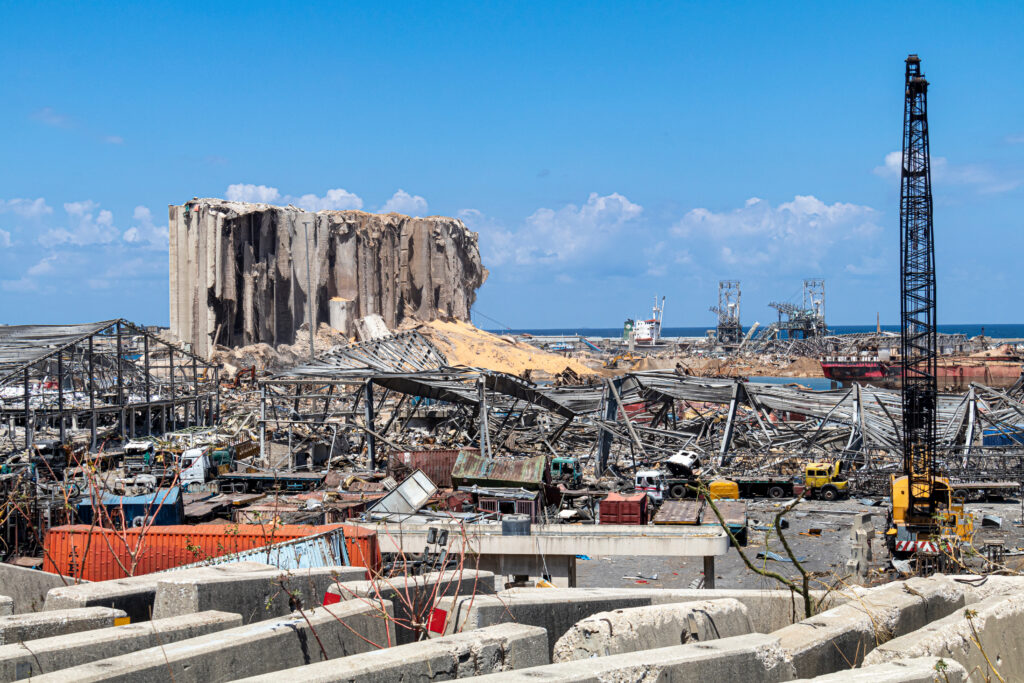
Above: Immediate aftermath of the Beirut explosion
Not An Isolated Incident
The Port of Beirut explosion demonstrated the severe and fatal consequences of underdeveloped customs procedures, chemical transport security, and physical protection measures, all of which permitted dangerous chemicals to sit abandoned in storage facilities at the Port for years. But it is far from the only incident in recent years.
As highlighted by these two events in 2021, securing hazardous chemicals in transport is a serious challenge:
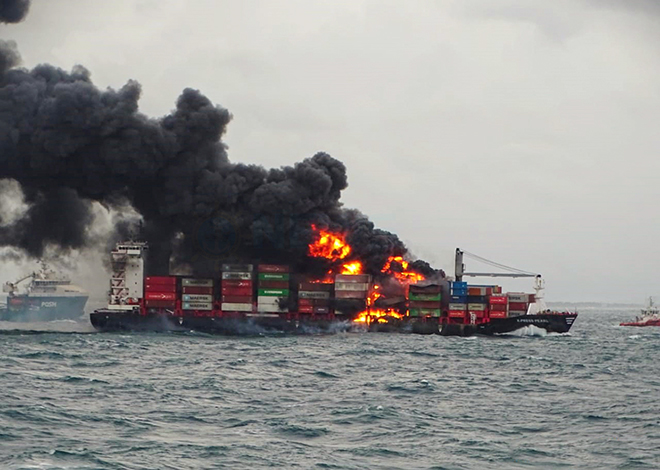
Image: India Coast Guard
The X-Press Pearl burned and sank off the coast of Sri Lanka in May 2021, reportedly after two ports had refused to off-load a container leaking nitric acid – typically used in fertilizers and explosives – because they lacked the expertise and facilities to tend to the leak. This produced an ecological catastrophe.1X-Press Pearl Slowly Settles to the Bottom,” The Maritime Executive, June 3, 2021, https://www.maritime-executive.com/article/x-press-pearl-slowly-settles-to-the-bottom.
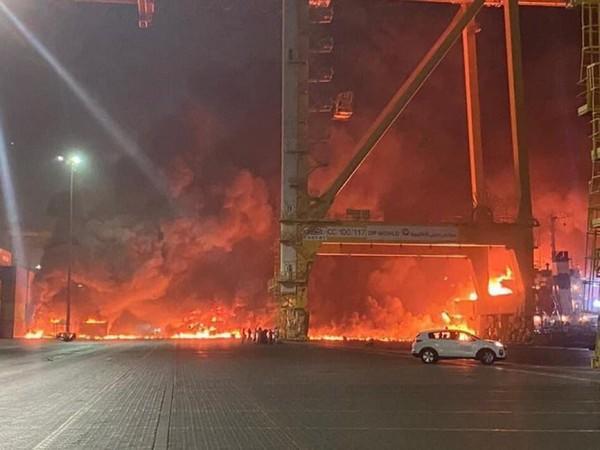
Image: TKTK
In July 2021 a container ship caught fire in Dubai’s Jebel Ali Port reportedly after a container holding cleaning products experienced high temperatures. Dubai Media Office’s (DMO) Director General described this event as a “normal accident.”2Caroline Faraj, Eleni Giokos, and Tamara Qiblawi, “Dubai’s Port Rocked by Huge Explosion on Container Ship,” CNN World, July 8, 2021, https://www.cnn.com/2021/07/07/middleeast/dubai-fire-port-jebel-ali-intl/index.html and Lisa Barrington and Alexander Cornwell, “Dubai Extinguishes Fire on Ship in Jebel Ali Port,” Reuters, July 8, 2021, https://www.reuters.com/world/middle-east/blast-heard-dubai-cause-unknown-reuters-witnesses-2021-07-07/.
For chemical materials to be traded, they need to be moved by road, rail, air, and ship. However, many of these materials are hazardous for human, animal, and environmental health, which means that their movements need to be controlled for safety and security.
Unfortunately, there are clear gaps in the standards for securing hazardous chemicals during transport. These gaps include challenges in implementing effective and harmonized security practices on the frontlines, where chemicals move in and out of countries.
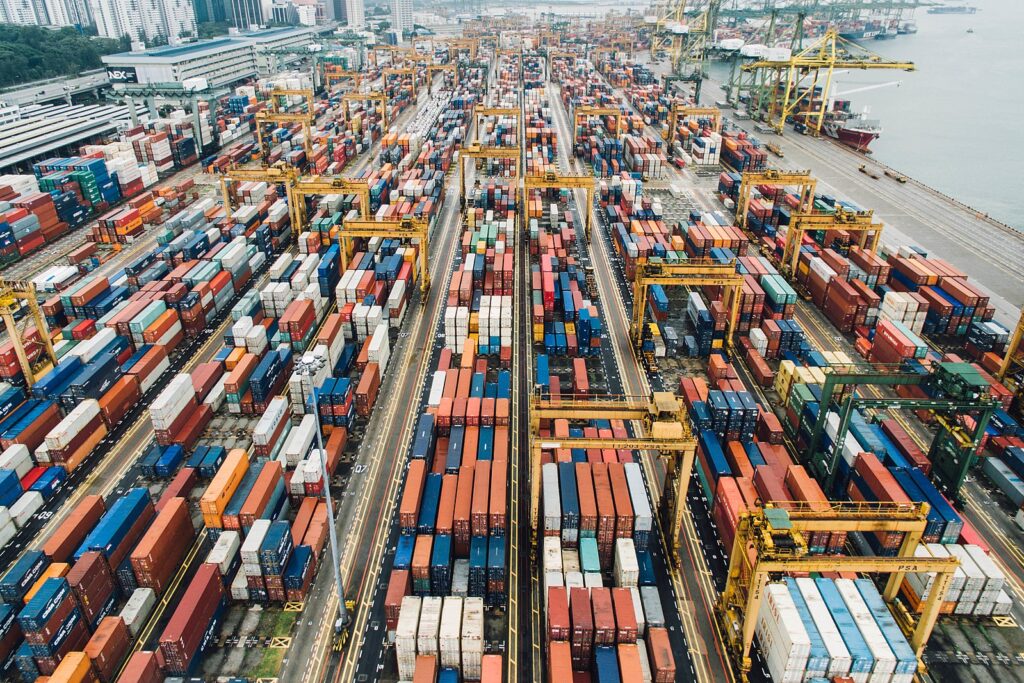
Chemical Transport: Common, Risky, and Mismanaged
Whether they are fatal events, ecological disasters, or “normal accidents”, the mishandling of hazardous substances during the transport stage poses a serious and perpetual risk to the international community. This is especially true when considering the danger of intentional misuse rather than accidental mishandling.
There is not a one-size-fits-all system for securing chemical transport; national controls over the chemical trade vary. Every country implements varying best practices and has different levels of capacity to control the transport of dangerous chemicals. This means that these materials are handled differently from port to port and often without regard for the chemicals’ properties.
Because of the high volume of global production and legitimate trade in chemicals, including toxic chemicals and chemicals of proliferation concern, implementing transport security measures is no small task and poses its own host of dynamic challenges.
Toxic chemicals and chemicals of proliferation concern are at their most vulnerable during transport.
Chemicals are generally well controlled at the point of manufacture and at the point of consumption. However, during transport very little note is given to the risk posed by chemicals, either from a toxicity perspective or a proliferation perspective. The challenge is to draw a line of control over the production and consumption of toxic chemicals and chemicals of proliferation concern that fully includes the transport phase. Over the years there has been significant growth in chemical production across the globe and, consequently, an increase in international trade of chemicals, including chemicals of proliferation concern.
Global chemical sales have tripled between 1999 and 2019 from approximately 1,200 billion Euros to 3,700 billion Euros.32021 Facts and Figures of the European Chemical Industry, Cefic, February 25, 2020, https://cefic.org/a-pillar-of-the-european-economy/facts-and-figures-of-the-european-chemical-industry/profile/#h-europe-is-the-second-largest-chemicals-producer-in-the-world. Approximately 700 new chemicals on average per year are introduced into American commerce and are added to the government’s Toxic Substance Control Act (TSCA) inventory.4John Stephenson, Chemical Regulation: Observations on Improving the Toxic Substances Control Act, United States Government Accountability Office, December 2, 2009, page 1, https://www.gao.gov/assets/gao-10-292t.pdf. Chemical weapons-related materials and precursors that are currently on this list include: Methylphosphonyl dichloride, arsenic trichloride, and hydrogen cyanide. Over 95% of manufactured goods are touched by chemistry.5Chemical Sector SDG Roadmap, World Business Council for Sustainable Development (WBCSD), July 2018, page 11, http://docs.wbcsd.org/2018/07/Chemical_Sector_SDG_Roadmap.pdf.
The volume of chemicals under transport at any given time poses the greatest risk.
Road and sea cargo containers can hold significant amounts of dangerous chemicals. Also, the mode of transport itself could be exploited as a chemical weapon delivery system. Ultimately, terrorists with specialist or inside knowledge could identify and highjack a chemical shipment and divert it to a busy city center or port. As a result, there are ample opportunities for terrorists to try and conduct an attack.
This is not a speculative threat. Data gathered on events between 1990 and 2017 shows that terrorist groups have used chemical materials as weapons almost four times more often than biological, radiological, or nuclear materials combined. In just 27 years, there are over 400 recorded events of chemical terrorism that have occurred in at least 59 countries on six continents.6Profiles of Incidents Involving CBRN and Non-state Actors (POICN) Database, University of Maryland, Accessed in Winter 2020, https://www.start.umd.edu/research-projects/profiles-incidents-involving-cbrn-and-non-state-actors-poicn-database.
In the past, several governments have reportedly indicated specific concerns about hijacked shipping vessels carrying dangerous chemicals being deliberately running into ports.7Marine Security of Hazardous Chemical Cargo, Congressional Research Service, August 26, 2005, page 4, https://www.everycrsreport.com/files/20050826_RL33048_82925aaaad31446330fe5147461650dfa764b1f2.pdf. The release of massive amounts of toxic chemicals could have significant terror and disruption effects around the world.
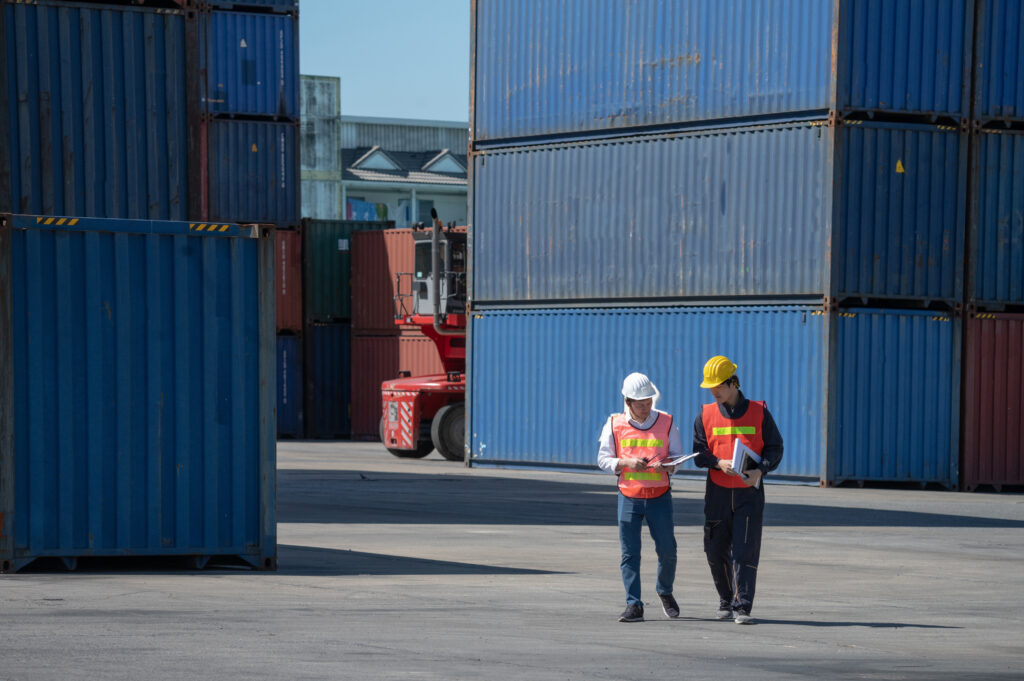
The first line of defense has limited technical knowledge and little time to verify the security of chemicals in transport.
The vulnerability of hazardous and toxic chemicals in transit is made worse by the burden that effective and practical control puts on frontline logistics and transportation workers. Protecting these chemicals requires being able to identify them and their associated risks. This job falls to frontline officers – the people who inspect shipping and materials as they move through ports, airports, and border facilities. They are expected to quickly and accurately identify toxic chemicals and chemicals of proliferation concern while maintaining the steady flow of a vast amount of cargo entering and exiting national borders. Rarely are these workers chemical specialists, yet the existing control regimes are too varied and too technical for a non-chemist to easily identify a chemical’s toxicity or proliferation risk.
Identification is only part of the challenge: Once a frontline officer is able to identify a controlled chemical in transport, they then need to navigate a tangle of international control regimes and domestic law to ensure that the chemical in question is actually being transported, secured, and stored safely and securely. Given that these responsibilities need to be completed without hampering the steady flow of commerce or incurring additional cost, it quickly becomes clear that the system is prone to failure.
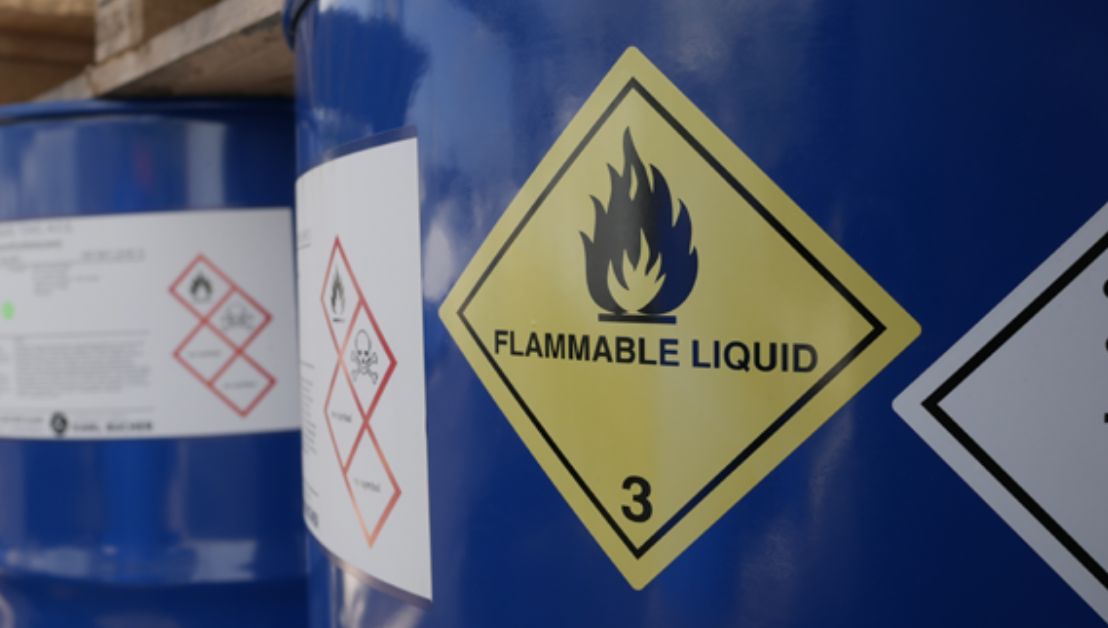
Poor National Implementation of UNSCR 1540 Puts International Community at Risk
Only 32 counties have specific laws and regulations for securing chemicals of proliferation concern.
All UN Member States are required by Security Council Resolution 1540 to implement specific procedures and measures to secure chemicals that pose a proliferation concern. However, only a small number of countries — just 32 in 2019 — have any laws or regulations governing security of chemicals of proliferation concern in general, never mind setting specific standards for chemicals in transit.8Richard Cupitt and Mary Vecellio, “Missing: Legal Frameworks for Chemical Security,”Strategic Studies Quarterly Vol 14, Winter 2020, https://www.airuniversity.af.edu/Portals/10/SSQ/documents/Volume-14_Issue-4/Cupitt.pdf?ver=AocQyuWi7ntwoXOGRHVDfg%3d%3d. 9Chemical Security Legal Index (ChemLEXIS), Stimson Center, https://chemlexis.www.stimson.org.
These national policies on transport security are important because they create legal mandates for producers, shippers, and regulators, especially related to enforcement of transport security practices.
The lack of a strong legal framework in more than 80% of UN Member States leaves the entire international community highly vulnerable.In 2019, the Stimson Center found that only 32 states had any laws or regulations to secure chemicals of proliferation concern.10Richard Cupitt and Mary Vecellio, “Missing: Legal Frameworks for Chemical Security,”Strategic Studies Quarterly Vol 14, Winter 2020, https://www.airuniversity.af.edu/Portals/10/SSQ/documents/Volume-14_Issue-4/Cupitt.pdf?ver=AocQyuWi7ntwoXOGRHVDfg%3d%3d.Of those, only 11 legally require supply chain verification. This means less than 6% of all UN Member States have a specific mandate to require their chemical industries to verify that end users are legitimate users of high-risk chemicals and related equipment.11Ibid.
Domestic policies establish requirements for how chemical materials should be contained, how they should be monitored (e.g., access controls, guns, and guards), and specifications on quantities. Importantly, in regard to materials like chemicals of proliferation concern, national policies can consider the risk-based threats of the material in transport to help mitigate vulnerabilities to terrorist exploitation. The limited number of national legal frameworks around the world on chemical security means that lapses by unregulated enterprises make them open to exploitation by terrorists. Massive quantities of toxic chemicals and new chemicals are flowing through the international trade system every day either ineffectively regulated or unregulated altogether. There is ample and never-ending opportunity for terrorists to exploit national ambiguities in stakeholder responsibilities and transport requirements.
Moving Forward: 7 Recommendations for Effective Chemical Transport Practices
Implementation of the following security practices by States would enhance national and international transport security, physical protection of chemicals of proliferation concern and mitigate the chemical terrorist threat. To guide consistent implementation, governments need a benchmark to work towards.


